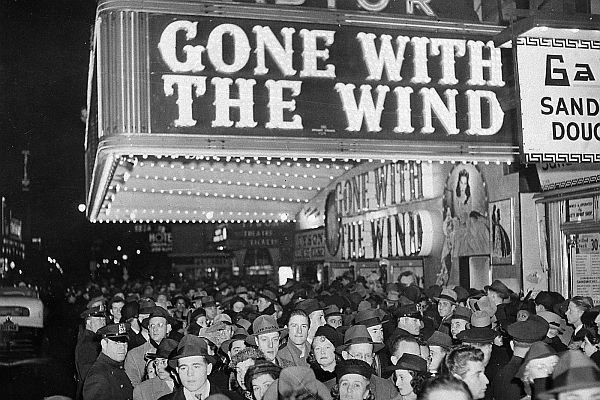Any understanding of Gone with the Wind – meaning both Margaret Mitchell’s novel and David Selznick’s film adaptation (henceforth GwtW – has to be contextualised within its status as a cultural treasure in North America. Only the Bible outstrips the novel in sales and over 200 million people have watched the movie in the United States and Canada.
Critical to interpreting GwtW is the knowledge that the Civil War was still etched in the living memory of the Atlanta in which the author was born, lived and died. Mitchell grew up on these memories and as a child was shown Sherman’s Sentinels, the chimneys of plantation mansions burnt in Sherman’s March to the Sea. The family lived on Jacksons Hill, above Darktown, the model for ‘Shantytown’ in GwtW. After the 1906 race riots in Darktown, they moved to Peachtree Street, on the north side of Atlanta, a similar location to Aunt Prittypat’s house in GWTW. Mitchell had relatives, with an Irish ancestry, who still lived in an old plantation house near Jonesboro. The name of the O’Hara plantation, ‘Tara’ probably came from Thomas Dixon jr’s 1905 historical romance, The Klansman, in which Dixon appropriated the old Scottish fiery cross summoning of the clans ‘crann tara’. The Klan appropriated both Dixon’s crann tara and costume in its second manifestation in 1915 and was still active when Mitchell began writing GwtW, in 1926. GwtW was published in 1936, the seventy-fifth anniversary of the outbreak of the Civil War. The film was premiered in Atlanta in 1939 amid costume balls and Confederate-flag waving.
Observing the differences between text and screen, not just in terms of Selznick’s adaptation, but also in terms of the inherent differences between the two mediums, provides insights not just into modern American cultural issues, but also the place of Gone with the Wind in an ongoing narrative that stretches back to the beginnings of civilisation.
Without being explicit, the text draws structure and content from both Homer and Hesiod. Beginning, in media res, at Tara in 1861, the novel follows Scarlett O’Hara’s fortunes during the war years, Reconstruction, and her eventual return to Tara. In her strength, cunning and voyage of return, Scarlett has much in common with Odysseus, while the blindly faithful Melanie Wilkes has a parallel in Odysseus’ long-suffering wife, Penelope.
The narrator in the text uses the citizens of Atlanta like a Greek chorus to explore the changing fortunes of the South. Heathcliffe-like, Rhett Butler is another persona of the narrator, appearing as the voice of reason cautioning against war with the Union, and constantly reminding Scarlett, and us, of her weaknesses and faults. As a facilitator, he is aptly surnamed Butler. The film replaces the narrator with scrolling banners, the first most famously proclaiming:
There was a land of Cavaliers and cotton fields called the Old South …
Here in this pretty world Gallantry took its last bow …
Here was the last ever to be seen of Knights and their ladies fair, of master and slave …
Look for it only in books, for it is no more than a dream remembered.
A civilization gone with the wind …
Unpacking the title goes some way towards explaining why GwtW has been so successful in promoting the Lost Cause mythology among white Americans. Sherman’s March to the Sea was the obvious wind which swept through Georgia. In borrowing ‘gone with the wind’ from Ernest Dowson’s poem Cynana, a plaintive yearning for ‘an old passion’ to whom he remains faithful, Mitchell tapped into a most powerful emotion, sehnsucht – the longing for a past that probably never existed and a future never to be realised.
The Reconstruction-era chapters begin with cold winds presaging the winnowing winds of Psalms 1:4, 35:5 and 83:13. Mitchell relentlessly strips the flawed supporting characters away, whilst retaining the gallantry and heritage of the Lost Cause, the reverence for the veterans and their memorials, the memory of the plantations and the gentility of their owners, and finally the hard, indomitable spirit of the white-supremacist Southerner.
Some critics have suggested that the film is too long, that the second part – in its challenging portrayal of Scarlett’s ruthless determination to become rich – should have been deleted. However difficult this is to watch has to be placed within the context of Selznick’s commitment to a faithful adaptation of Mitchell’s text. Scarlett is complex. Her dissembling and predatory nature draws upon both Calypso and Circe. Curiously, her rugged individualism is more akin to Northern values than Southern, and probably resonated with working women. It can be argued that Mitchell crafted Scarlett O’Hara, in all her ruthless passion, as a Trojan horse, a gift to the Yankees, both concealing and perpetuating the Lost Cause.
Both the novel and the film occupy a special place in American popular culture, helping modern White America find compromise and healing-salve in the still-raw wounds of the Civil War – at the cost of Black America. GwtW must be further contextualised within the Black Lives Matter Movement, which is an extension of the Civil Rights movement, which in turn, was a reaction to the Jim Crow Laws that the North allowed the South to enact as the price for preserving the Union. As Fanon shows in The Wretched of the Earth, movements like BLM are reality checks on the perception that mythology and memorialisation are history and that the past is done with us.
Both novel and film are a dissemblage, a fabrication of Southern history. Slavery was not benevolent. Miscegenation was rife on the plantations. Rhett’s speech at Twelve Oaks, promoting one of the Lost Cause most popular myths, ie that the gallant South was overwhelmed by the North’s big battalions, is a lie. Robert E Lee’s aggressive attempts to conquer the North bled the South dry. Slave owners were compensated, not disadvantaged when their slaves were recruited to build fortifications. The Klan was widespread across the South, it was not founded in Atlanta because the men were angered by Scarlett riding alone. Rhett and Ashley did not dismantle the Atlanta Klan, turning them into Democratic voters. Federal indifference rather than scallywag and carpetbag corruption brought about the end of Reconstruction.
The film softened these lies even further by not addressing the role of the Klan and by erasing Mitchell’s offensive language. It is no accident that GwtW ends with the failure of Reconstruction. Taking it any further would mean acknowledging the Jim Crow Laws. The slave laws of Georgia forbade manumission, therefore Ashley Wilkes would not have been able to free his slaves. The strangest scene in GWTW is the marital rape scene – not so much for the rape itself, nor Scarlett’s sweet surrender, but for Scarlett’s sado-masochistic desire to hold a whip over Rhett’s dark head. Mitchell had bizarre ideas about slavery.
Only near the end of the novel, when Rhett describes Scarlett as being like the giant Anteaus who drew his strength from being in contact with the earth, and Scarlett returns to Tara to lay her head upon the broad bosom of Mammy, do we realise that Mitchell is referencing Hesiod’s wide-bosomed Gaia, earth-goddess and mother of Anteaus. In reducing Mammy into a nurturing earth-mother for Scarlett’s renewal, Mitchell reaches back to the blood-sacrifices of the early farmers. Despite Scarlett’s protestations that ‘Tomorrow is another day’, GwtW is backwards looking, constantly drawing its strengths from past conquests, past flights, past renewals. The ancestors of Mitchell’s protagonists were ruthless, New World opportunists. Peachtree Street was laid over the Cherokee Peachtree trail. Prissy, the most awkward of the slaves, had a mixed Afro-American and Native-American ancestry which was erased in the film.
GwtW has an ancient lineage reaching back to the early settlers leaving the steppes and the Fertile Crescent with their crops, animals, bronze weapons and disease, largely indifferent to the waste and unfinished business left in in their trail.
Implicit, but unacknowledged, Scarlett’s return to Tara, like Odysseus’ to Ithaca, will be melancholic. Scarlett O’Hara will assume Miss Havisham’s mantle. The Lost Cause is a fata morgana.
As unfinished business, GwtW evokes both Proverbs 11:29 (‘He that troubleth his own house shall inherit the wind: and the fool shall be servant of the wise of heart’) and Walter Benjamin’s ‘angel of history’ propelled backwards into the future by the catastrophic wreckage of the past.
The iconic status of GwtW in the United States demonstrates the near impossibility of settler societies recognising how dangerous they are, and how much damage they have caused. To paraphrase Walter Benjamin again, cultural treasures have origins that cannot be contemplated without horror.
In the global context of the settler narrative, Reconciliation is only a tokenistic gesture by settler societies to salve their conscience. ‘I can’t breathe’ were the last words of David Dungay and over seventy Afro-Americans who have died in police custody. As Deleuze and Guattari wrote in Anti-Oedipus, ‘the cops are there to replace the high priests’.
Truth is only meaningful as a mirror for settler societies to reconcile themselves to their true nature. In the decades following Mitchell’s death, Atlanta’s Black population increased, and the city became a hub for the Civil Rights Movement. This month, the Black voters of Atlanta helped turn the tide against Trump. As Donald chills, Gone with the Wind will be the old movie he goes to see with a friend.



